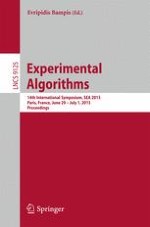This book constitutes the refereed proceedings of the 14th International Symposium on Experimental Algorithms, SEA 2015, held in Paris, France, in June/July 2015.
The 30 revised full papers presented were carefully reviewed and selected from 76 submissions. The main theme of the symposium is the role of experimentation and of algorithm engineering techniques in the design and evaluation of algorithms and data structures. The papers are grouped in topical sections on data structures, graph problems, combinatorial optimization, scheduling and allocation, and transportation networks.
